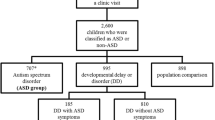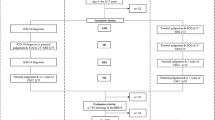Abstract
The current study examined the factor structure of restricted and repetitive behaviors (RRB) in children with autism. Factor extraction procedures of 12 items from the Autism Diagnostic Interview-Revised (ADI-R) were applied in N = 207 individuals with autism. Two interpretable factors were identified: Factor 1—repetitive sensory motor actions and Factor 2—resistance to change. There was a significant negative correlation between an index of level of adaptive functioning and Factor 1. Intraclass correlations were not significant for either factor in a subset of families with two or more siblings with autism (multiplex). No differences in scores were apparent for either factor when multiplex families and families containing only one affected individual with autism (singleton) were compared. RRB in autism are represented by two distinct factors which may reflect two separate groups within autism. Defining subgroups within autism will allow for reduction of clinical heterogeneity and enhance our ability to dissect the genetic etiology of this complex disorder.
Similar content being viewed by others
References
American Psychiatric Association: Diagnostic and Statistical Manual of Mental Disorders (DSM-IV), Washington,D.C., American Psychiatric Press, Inc.; 1994.
Lewis M.H., Bodfish JW: Repetitive behavior disorders in autism. Mental Retardation & Developmental Disabilities Research Reviews 1998;4:80-89.
Evans DW, Leckman JF, Carter A, et al.: Ritual, habit, and perfectionism: the prevalence and development of compulsive-like behavior in normal young children. Child Dev. 1997;68:58-68.
Bodfish JW, Symons F, Lewis M: The Repetitive Behavior Scales: A test manual, Morganton, North Carolina, Western Carolina Center Research Reports; 1999.
Bodfish JW, Crawford TW, Powell SB, P arker DE, Golden RN, Lewis MH: Compulsions in adults with mental retardation: prevalence, phenomenology, and comorbidity with stereotypy and self-injury. Am. J. Ment. Retard. 1995;100:183-192.
Bodfish JW, S ymons FJ, Parker DE, Lewis MH: Varieties of repetitive behavior in autism: comparisons to mental retardation. J. Autism Dev. Disord. 2000;30:237-243.
Turner M: Annotation: Repetitive behaviour in autism: a review of psychological research. J. Child Psychol. Psychiatry 1999;40:839-849.
Mink JW: Basal ganglia dysfunction in Tourette's syndrome: a new hypothesis. Pediatr. Neurol. 2001;25:190-198.
Sears LL, Vest C, Mohamed S, Bailey J, Ranson BJ, Piven J: An MRI study of the basal ganglia in autism. Prog. Neuropsychopharmacol. Biol. Psychiatry 1999;23: 613-624.
Robertson JM, Tanguay PE, L'ecuyer S, Sims A, Waltrip C: Domains of social communication handicap in autism spectrum disorder. Journal of the American Academy of Child & Adolescent Psychiatry 1999;38:738-745.
Tanguay PE, Robertson J, Derrick A: A dimensional classification of autism spectrum disorder by social communication domains. J. Am. Acad. Child Adolesc. Psychiatry 1998;37:271-277.
Lord C, Rutter M, Le Couteur A: Autism Diagnostic Interview-Revised: a revised version of a diagnostic interview for caregivers of individuals with possible pervasive developmental disorders. J. Autism Dev. Disord. 1994;24:659-685.
Sparrow, S. S., Balla, D., and Cicchetti, D. Vineland Adaptive Behavior Scales, Interview Edition, Survey Form. 1984. Circle Pines, MN, American Guidance Service. (GENERIC) Ref Type: Pamphlet
Aman MG, Burrow WH, Wolford PL: The Aberrant Behavior Checklist-Community: factor validity and effect of subject variables for adults in group homes. Am. J. Ment. Retard. 1995;100:283-292.
Lord C, Pickles A, McLennan J, et al: Diagnosing autism: analyses of data from the Autism Diagnostic Interview. J. Autism Dev. Disord. 1997;27:501-517.
MacLean JE, Szatmari P, Jones MB, et al: Familial factors influence level of functioning in pervasive developmental disorder. Journal of the American Academy of Child & Adolescent Psychiatry 1999;38:746-753.
Spiker D, Lotspeich LJ, Dimiceli S, et al: Behavioral phenotypic variation in autism multiplex families: Evidence for a continuous severity gradient. Am. J. Med. Genet. 2002;114:129-136.
SAS Institute: SAS/STAT User's Guide (Version 8), Cary, NC, Author; 2000.
Singer JD: Using SAS PROC MIXED to Fit Multilevel Models, Hierarchical Models, and Individual Growth Models. Journal of Educational and Behavioral Statistics 1998;24:323-355.
Carmines, E. G and Zeller, R. A. Reliability and validity assessment. 1979. London, Sage Publications. Sage University Paper series on Quantitative Applications in the Social Sciences 07-017. (GENERIC) Ref Type: Serial (Book,Monograph)
Liss M, Harel B, Fein D, et al: Predictors and correlates of adaptive functioning in children with developmental disorders. J. Autism Dev. Disord. 2001;31:219-230.
Evans DW, Gray FL: Compulsive-like behavior in individuals with Down syndrome: its relation to mental age level, adaptive and maladaptive behavior. Child Dev. 2000;71:288-300.
Berkson G, Tupa M, Sherman L: Early development of stereotyped and self-injurious behaviors: I. Incidence. Am. J. Ment. Retard. 2001;106:539-547.
Shao Y, Raiford KL, Wolpert CM, et al: Phenotypic Homogeneity Provides Increased Support for Linkage on Chromosome 2 in Autistic Disorder. Am. J. Hum. Genet 2002;70.
Author information
Authors and Affiliations
Corresponding author
Rights and permissions
About this article
Cite this article
Cuccaro, M.L., Shao, Y., Grubber, J. et al. Factor Analysis of Restricted and Repetitive Behaviors in Autism Using the Autism Diagnostic Interview-R. Child Psychiatry Hum Dev 34, 3–17 (2003). https://doi.org/10.1023/A:1025321707947
Issue Date:
DOI: https://doi.org/10.1023/A:1025321707947




